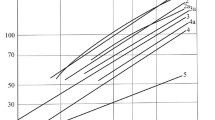The author has presented results of calculating the efficiency of porous channels during the evaporation of a vapor– liquid Freon flow in the transition region of motion of the heat-transfer agent and with boundary conditions of the first kind. For the sake of comparison, use was made of a smooth-wall tube as the reference surface. As a result of the conducted investigations, it has been shown that with the Freon 12 heat-transfer agent, positive values of geometric and energy coefficients of efficiency can be obtained. The dependences of the efficiency coefficients on the basic operating-structural parameters of the model have been analyzed.
Similar content being viewed by others
References
A. A. Gogolin, G. N. Danilova, V. M. Azarskov, and N. M. Mednikova, Enhancement of Heat Transfer in Evaporators of Refrigerating Machines [in Russian], Legkaya i Pishchevaya Promyshlennost’, Moscow (1982).
I. V. Kalmykov, Heat Transfer and Hydrodynamics during the Motion of a Steam–Water Flow in Porous Media, Candidate’s Dissertation in Technical Sciences, Moscow (1987).
V. M. Polyaev, V. A. Maiorov, and L. L. Vasil’ev, Hydrodynamics and Heat Transfer in Porous Elements of Space and Air Craft Structures [in Russian], Mashinostroenie, Moscow (1988).
A. P. Lukisha, Heat transfer during the evaporation of the flow in a cylindrical porous channel, Visn. Dnipropetr. Univ., 22, No. 5 (2014), Ser. Mekhanika, 1, No. 18, 107–114.
R. W. Lockhart and R. C. Martinelli, Proposed correlation of data for isothermal two-phase, two-component flow in pipes, Chem. Eng. Prog., 45, No. 1, 39–48 (1949).
Yu. A. Zeigarnik and I. V. Kalmykov, Experimental study of the hydraulic resistance of porous structures in adiabatic motion of steam–water mixtures, Teplofi z. Vys. Temp., 23, No. 5, 934–940 (1985).
A. P. Lukisha, Procedure of recalculation of thermohydraulic characteristics of porous once-through steam generators from second-kind boundary conditions for first-kind boundary conditions, in: Systems Design and Analysis of the Characteristics of Aerospace Equipment, Collected Scientifi c Papers, Vol. XXII [in Ukrainian], Dnipropetr. Nats. Univ. im. O. Gonchara, “Lira,” Dnipro (2017), pp. 97–106.
A. P. Lukisha, Calculation of the thermohydraulic efficiency of porous once-through steam-generating channels in the transition region of motion of the heat-transfer agent and with boundary conditions of the first kind, XV Minsk Int. Forum on Heat and Mass Transfer, 23–26 May, 2016, Abstracts of Papers and Reports, Vol. 1, pp. 364–368.
N. B. Vargaftik, Handbook of Thermophysical Properties of Gases and Liquids [in Russian], Nauka, Moscow (1972).
V. V. Altunin, V. Z. Geller, E. A. Kremenevskaya, I. I. Perel’shtein, and E. K. Petrov (S. L. Rivkin Ed.), Thermophysical Properties of Freons, Vol. 2. Methane-Series Freons [in Russian], Izd. Standartov, Moscow (1985).
V. A. Maiorov, Enhancement of heat transfer in flow evaporation in a channel with a porous high-thermal-conductivity filler, Prom. Teploénerget., 3, No. 4, 22–28 (1981).
Author information
Authors and Affiliations
Corresponding author
Additional information
Translated from Inzhenerno-Fizicheskii Zhurnal, Vol. 94, No. 5, pp. 1212–1220, September–October, 2021.
Rights and permissions
About this article
Cite this article
Lukisha, A.P. Calculating the Thermohydraulic Efficiency of Porous Steam-Generating Channels in the Transition Region of Motion of a Freon 12 Heat-Transfer Agent with Boundary Conditions of the First Kind. J Eng Phys Thermophy 94, 1185–1193 (2021). https://doi.org/10.1007/s10891-021-02399-2
Received:
Published:
Issue Date:
DOI: https://doi.org/10.1007/s10891-021-02399-2




